When I first started teaching the open number line subtraction strategy, I hated it. I felt like my 2nd grade students could not accurately get answers to 2-digit subtraction on a number line. All their numbers would be jumbled up underneath the open number line. And if students were off by one number early on when solving subtraction on an open number line, their answer would just get further and further away from the correct answer as they solved.
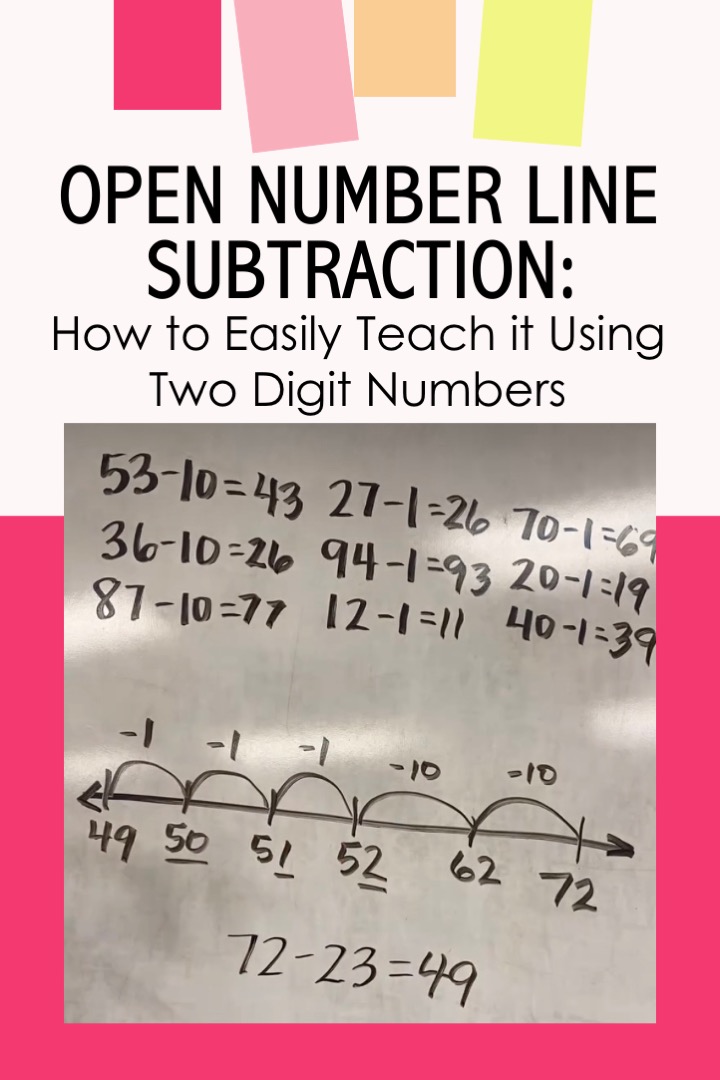
Here’s exactly how I teach the open number line subtraction strategy to my 2nd grade students.
So it got me thinking about how I could help my students accurately and effectively use the open number line subtraction strategy for 2-digit numbers.
As I studied this strategy more and more, I realized that students needed to know certain patterns in order to do the mental math involved in the open number line subtraction strategy. Once students got practice with those patterns, they didn’t get caught up on the math. They could just follow the steps of the strategy and get accurate answers.
As I saw students solve subtraction on an open number line, I took note of common mistakes students made. I went over these as I first introduced the strategy.
I have a free guide that outlines all the patterns and common mistakes for each of the 2-digit addition and subtraction strategies. Grab your free copy here: The Ultimate Teaching Guide for 2-Digit Addition & Subtraction Strategies
Helping students learn patterns and helping them avoid common mistakes was a game changer when it came to teaching 2-digit subtraction on a number line.
Students understood the strategy and their answers were correct!
So if you are struggling to teach open number line for subtraction, this blog post is going to be extremely helpful for you.
I’m going to share exactly how I teach this strategy to my 2nd grade students. Teaching open number line 2-digit subtraction in this way helps students find success. I’m so excited to share it with you!
But first… If you’re a parent who has a child struggling with math, you’ve got to check out Learner. Learner is an online tutoring platform that sets students up for success. To get started take a short quiz about your child’s needs. Then Learner’s Success Management Team reviews that and matches your child with the perfect tutor. Get your $25 trial here.
Open Number Line Subtraction
Let’s first talk about what this strategy is. There are actually 2 ways you can solve subtraction equations on an open number line. You can count back to subtract, or you can add up to subtract. I’ll share both ways.
With count back to subtract, you start on the right side of the number line and make jumps of tens and ones back. You land on your answer.
With adding up to subtract, you put the larger number in your equation on the right side of the number line. You put the lesser number in the equation on the left side of the number line. Then you make tens and ones jumps from the lesser number to the greater number. For your answer, you add up all the jumps you made.
Adding up to subtract works because you can use addition to subtract. For example, if I saw an equation like 7-5, I could think 5 plus what equals 7. 5+2=7, so 7-5=2. To help students remember this, I like to review fact families. Read more about how I teach fact families in this blog post here.
Okay, so let’s now get into exactly how I teach 2 digit subtraction on a number line.
2 Digit Subtraction on a Number Line
Counting Back
I like to introduce the strategy by using display pages. These help me share the learning target, model the strategy, and give guided practice problems to my students. But before I show anything on a number line, I like to teach my students the patterns that go with the open number line subtraction strategy. I use display pages that give equations that match these patterns so that students can learn the patterns quickly.
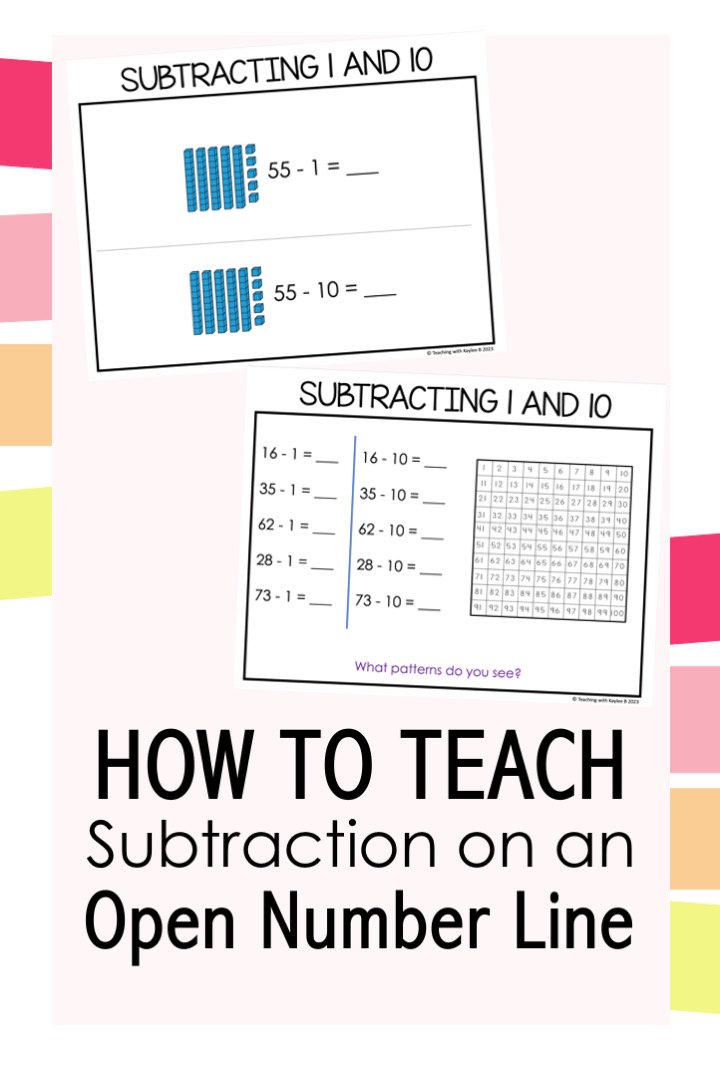
Success with subtraction on an open number line comes by teaching the patterns involved in the strategy.
I want students to be able to subtract 1 and 10 from a 2-digit number mentally. So I show examples of 2-digit numbers with place value blocks. Then students cross off a one or a ten to get to the answer. Then I have them solve a bunch of these examples with a hundreds chart. I have students look at the answers and ask what patterns they see. They should see that when we subtract 1, the number in the ones place decreases by one. Students should also see that when we subtract 10, the number in the tens place decreases by one.
There is another pattern that students need to learn. It’s when the 2-digit number we are subtracting from has a zero in the ones place and we subtract 1 from that number. I have students solve a bunch of these equations using a hundreds chart and then ask what patterns they see. Students should notice that the tens number decreases to one, and the ones number changes to a 9. I call this pattern our “special zero pattern.”
Once I know students have these patterns down, then I model solving a couple problems. I show them how to put their starting number on the right side of the number line. Then I model to them how to make the jumps of tens and ones back to get their answer.
Let’s go into a little more detail with an example so you can know exactly what I am talking about. I’ll use the equation 85-22.
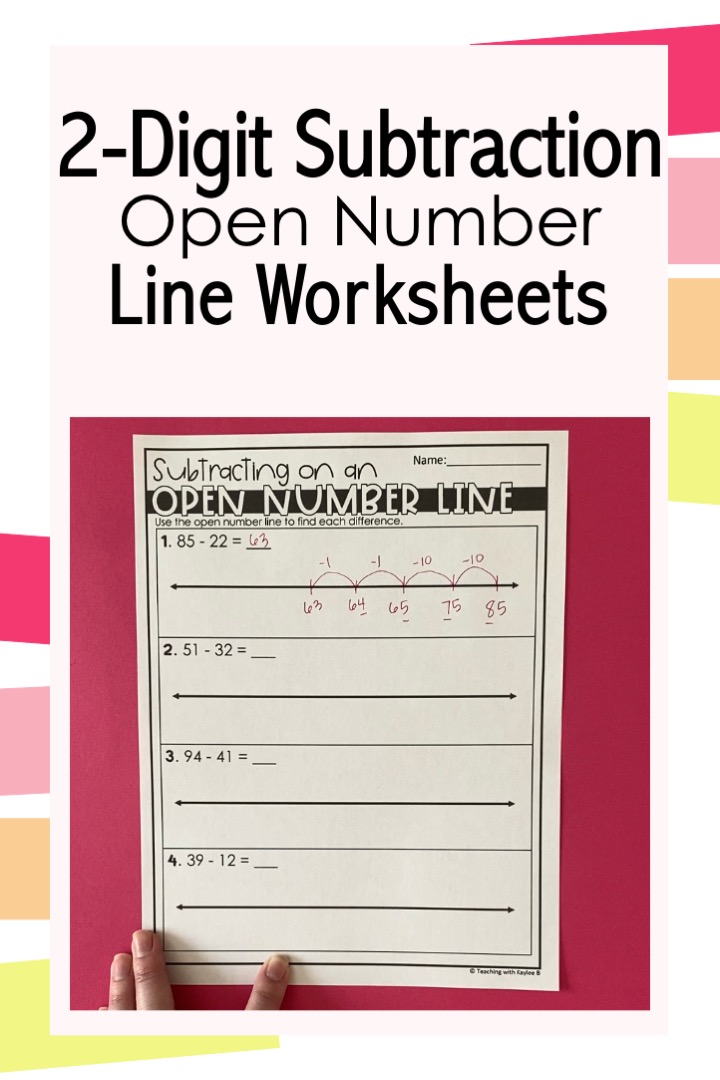
Give students plenty of practice with this 2-digit subtraction open number line worksheet.
I put a “tick” on the right side of the number line. Then I label it 85 underneath. After that I think about how many tens I need to subtract. There are 2 tens in 22 so I make 2 tens jumps back from 85. I label them “-10” up above. Down below I label the numbers 75 and 65.
Then we look at how many one jumps we need to make. There are 2 ones in 22 so I make 2 one jumps back from 65. I label the jumps “-1” up above. Down below, I follow our ones pattern and write 64 and 63. We landed on 63 so that’s the answer.
As I model solving using the open number line subtraction strategy, I am “thinking out loud.” By that I mean I am explaining every step and why I’m doing it.
Then it’s time to do another example problem, but this time I ask students questions as we solve. These might be questions, like “What do you do first?” “Now what do we do?” or “What number goes here?”
I also like to model solving another equation but this time I make my jumps small and write the numbers underneath really big. This is funny to students because they see all the numbers jumbled up. I do this because it helps students see the importance of drawing big enough jumps and to write the numbers underneath small. It helps so much to show this essential when students get their own practice with a 2-digit subtraction open number line worksheet.
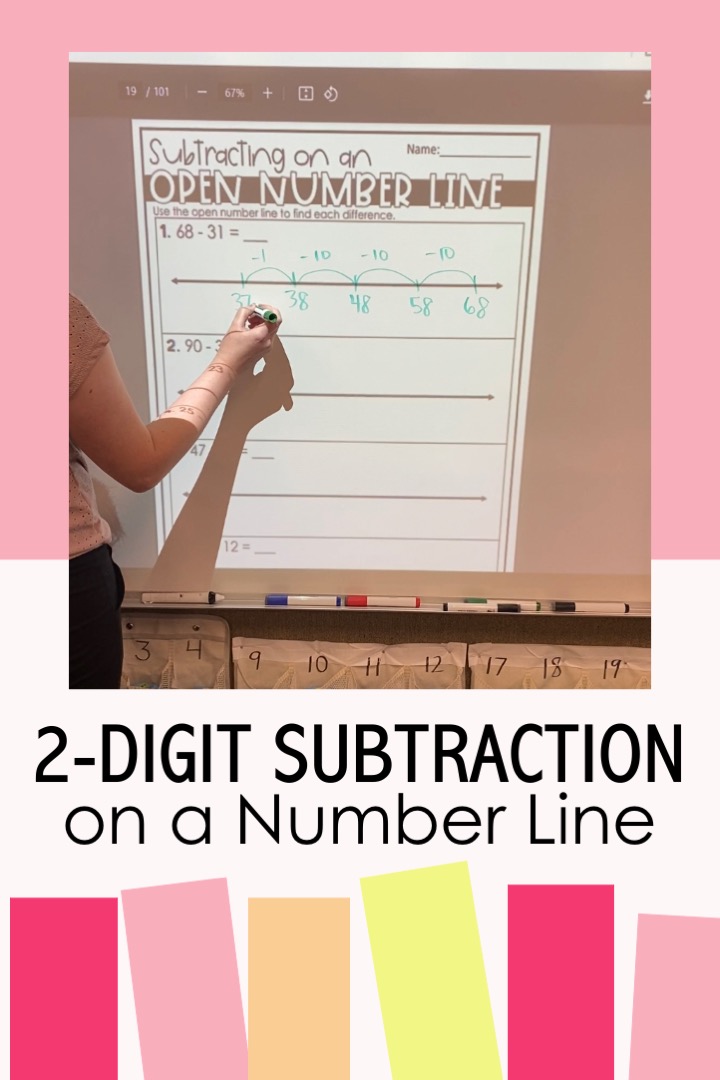
I like to display the worksheet on the board and do a couple 2-digit subtraction on a number line problems together as a class.
I have students do a couple problems together with me on the worksheet. I display the worksheet up on the board. We make jumps and write the number together. Then I have students do the rest of the worksheet by themselves. I walk around and give support to students. As you do this, take a mental note of common mistakes. After some time, call students’ attention back and go over those common mistakes.
Then students are ready for independent practice. I like to give students another worksheet, but this time they complete it without me walking around. When students are finished, they meet me at our classroom table. I do a quick check over their work and I help them fix any mistakes. When their work looks good, I draw a big check mark on their page with one of my smelly markers. Then students put this page in their Take Home Binder.
I like checking work this way because students get immediate feedback. Plus, I don’t have to check papers after school! Also, parents are able to see their page that night and see how their child is doing with the open number line subtraction strategy.
After students put their page away, I give them a partner and they complete a couple fun open number line for subtraction activities.
The first one is a scoot activity. I tape up task cards around my classroom. Then students go around and solve the problems. I have them write their answer on a recording sheet to keep them accountable. Then they check their own work with a red pen and an answer key I have set out.
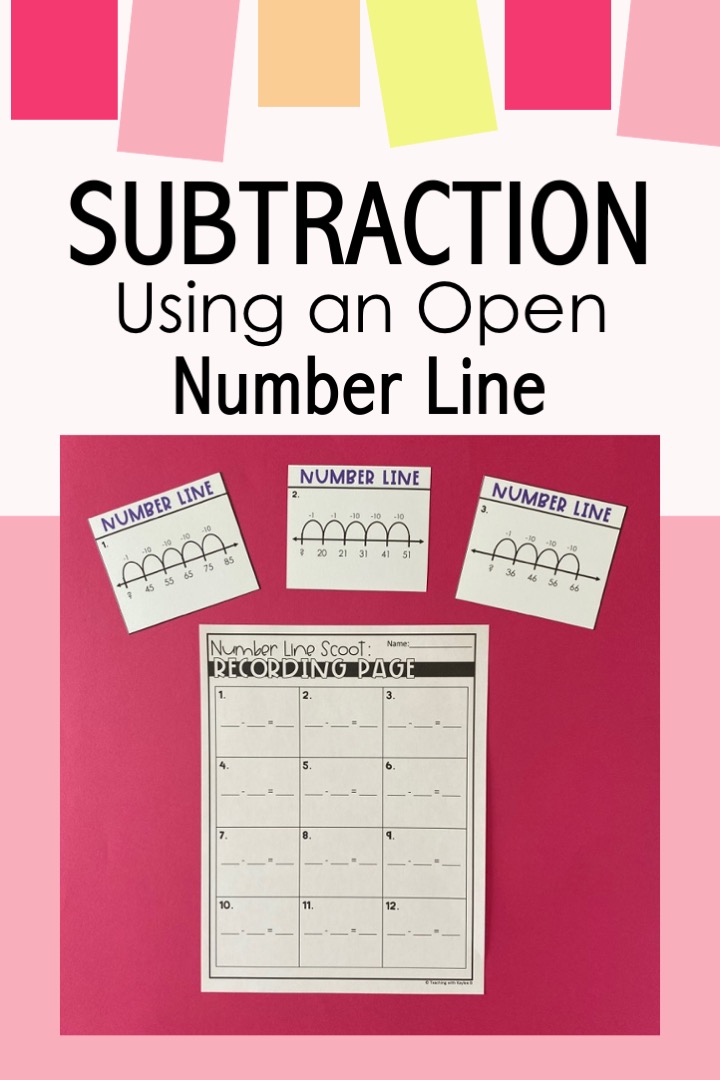
Students need a lot of practice to master subtraction using an open number line. That’s why I like them to do this scoot activity..
Find this scoot activity here.
Then students do a fun open number line subtraction puzzle activity. Students lay out the number line sheets and then put the little number cards where they should fit on the number line. I love these because they help students really focus on using those patterns to solve.
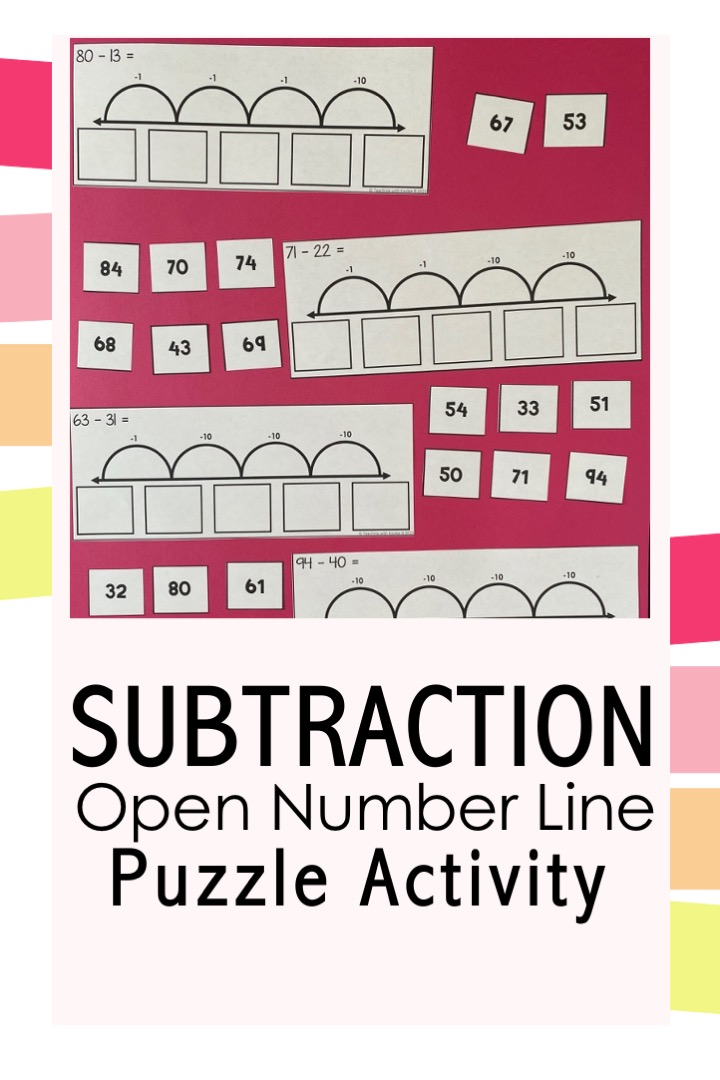
Students need more practice with the open number line 2-digit subtraction strategy? Get them hands on practice with this number line puzzle.
Find this puzzle activity here.
And finally, I have students complete an exit ticket so I can get a good idea on who still needs help mastering this strategy. Students rate themselves on how they feel they understood the lesson. They also solve a couple subtraction problems on an open number line. I look at these after school and take note of which students could use a little more practice during centers.
And that’s how I teach subtraction on an open number line using the counting back method. But remember, you can also add up to subtract on an open number line. So I have a lesson the next day on this way to solve 2-digit subtraction on a number line.
Subtraction on an Open Number Line
Adding up to Subtract
I use display pages to introduce the strategy. Again, this gives me the learning target and examples to model using this method. These also show how using addition for subtraction works. It’s nice having everything I need to introduce the strategy all in one place.
I do a practice problem where I model how to solve by adding up to subtract. Let me show you how I do this with an example. Let’s look at the equation 73-52.
I show how to put 73 on the right side of the number line and 52 on the left side. Then I start at 52 and make as many jumps of 10 as I can. I make one jump, label it “+10” up above, and 62 down below. Then I make another jump, label it “+10” up above, and write 72 down below. I can’t do another ten jump because that would get us over 72, so I then make my ones jumps. So I make a one jump, label it “+1” up above, and that gets up to 72. Then to get our answer I add up all our jumps. 10+10+1=21, so the answer is 21.
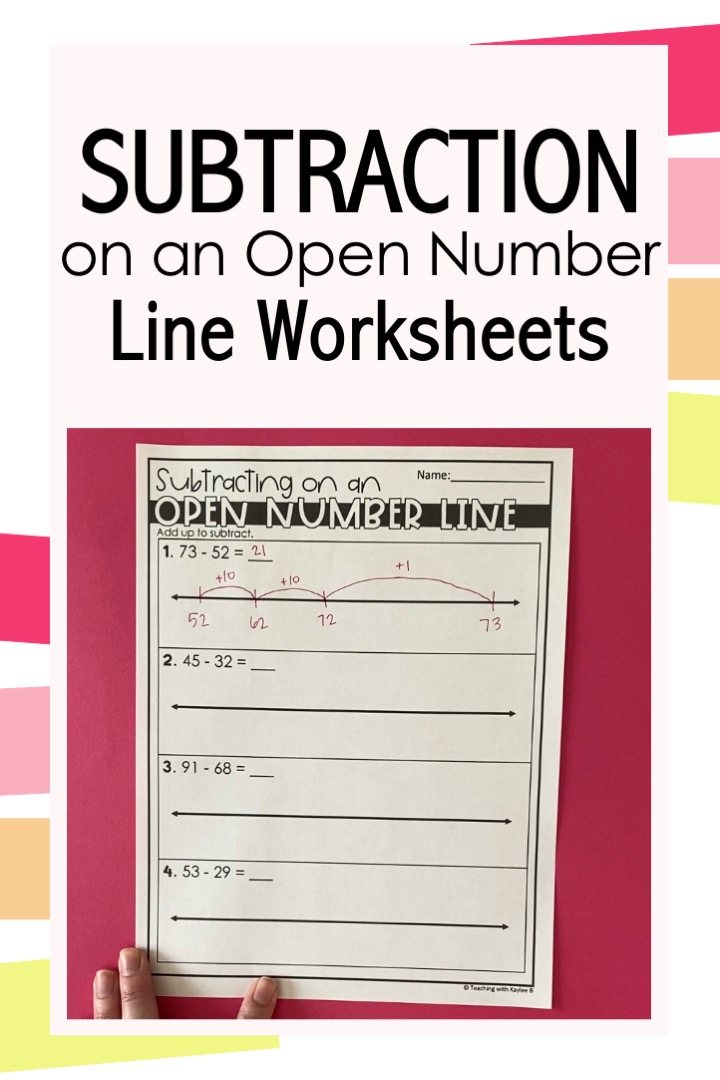
This subtraction on an open number line worksheet gives students plenty of room to make the jumps they need to solve.
We do another practice problem when I get students more involved by asking them questions as we solve. These questions may be like “What do you do to start?” Now what do we do?” Can we make another ten jump or do we need to switch to ones?”
After that, it’s time to get students guided practice. I give them a 2-digit subtraction open number line worksheet. We do the first couple together. That means I display up the worksheet and students write what I write. I continue to ask questions to get them involved.
Then students complete a couple problems by themselves. I walk around and help students as needed. After a bit, I call students’ attention back and we review the problems they do. I address any common mistakes or misconceptions.
Then it’s time for independent practice. I give students another 2-digit subtraction open number line worksheet. This time they complete it by themselves. I wait at our classroom table. When students finish they come line up by me. I check their work and help them fix any mistakes. When their work looks good, I give them a check mark on their page with one of my special smelly markers. Then students put their page in their Take Home Binder.
After that, students are ready for some extra practice activities.
I like to partner students up to complete a scoot activity. I have task cards taped up around the room. On these cards, there are solved number lines and students write down their matching equation on their recording sheet. Once students finish these, they check their own work with a red pen and an answer key I’ve set out.
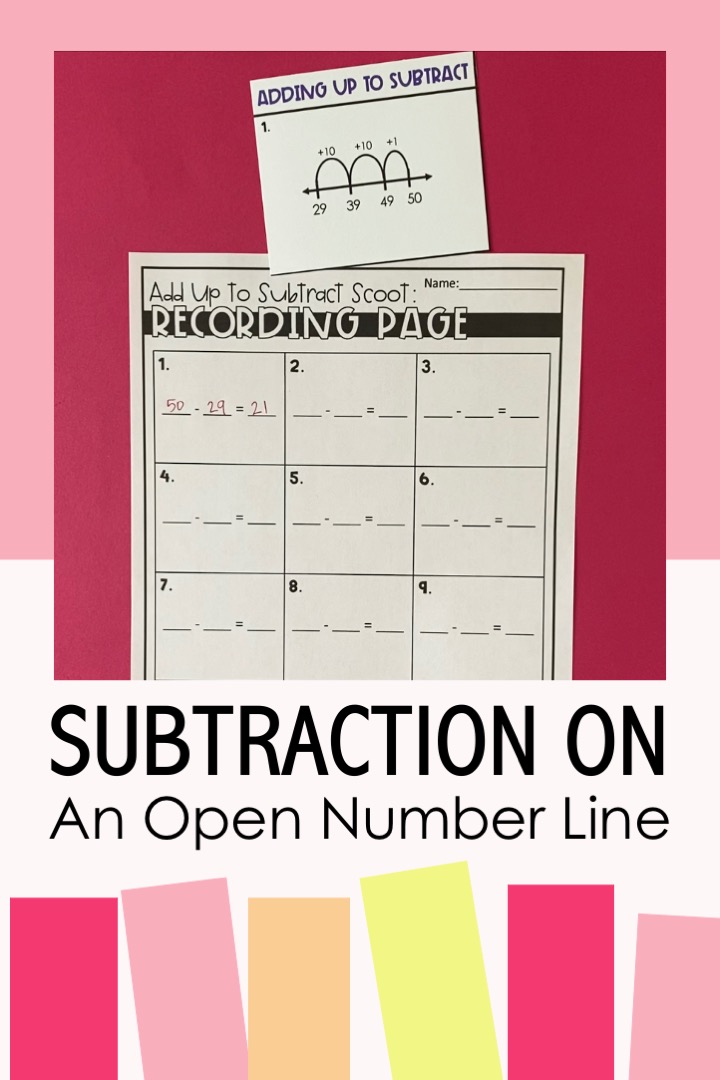
Help students practice adding up to subtract on an open number line.
Find this scoot activity here.
Then students complete a fun puzzle activity. They match the number line, with its equation, with its answer. Once students are done, I have them raise their hands and I do a quick look over their work. Then students mix up the pieces, stack them up, and they are ready for the next set of students.
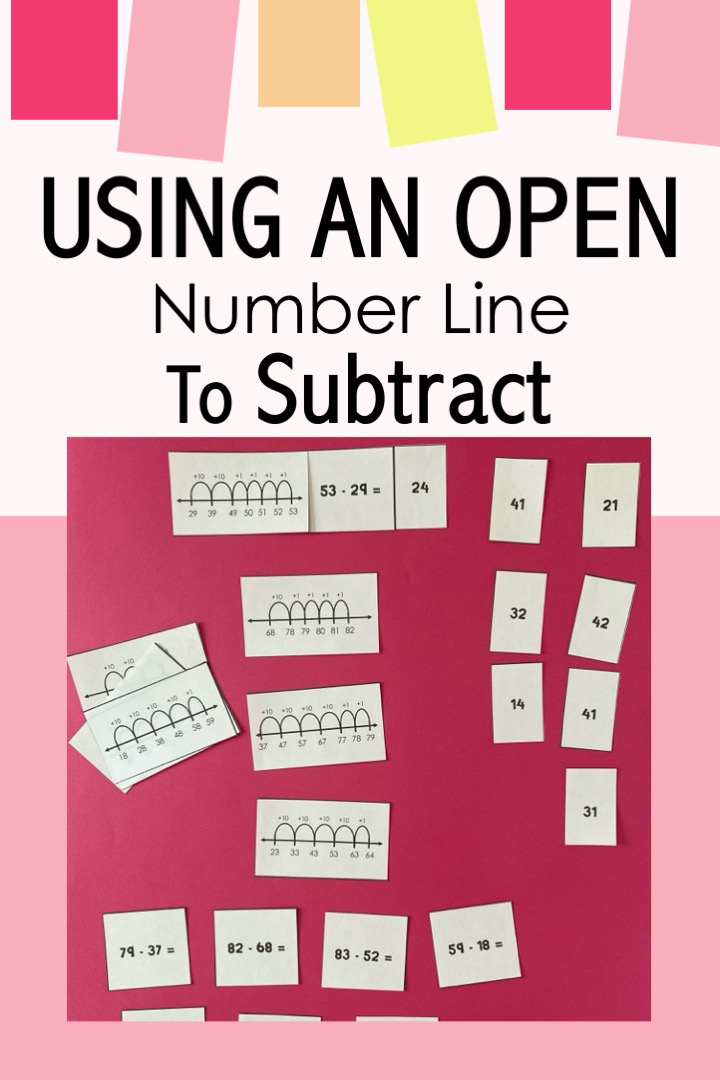
This puzzle is a fun way for students to get hands-on practice for using an open number line to subtract.
Find this puzzle activity here.
And finally, I have students complete an exit ticket. Students rate themselves on how they think they understood the lesson. They also solve a couple equations adding up to subtract on an open number line.
I look at these later that day. This helps me take note of students that could use some extra practice during centers.
Find all of my 2-digit subtraction on a number line resources I use in my classroom here.
You can find this resource in a money saving bundle here. This bundle includes all of my 2-digit addition and subtraction strategy resources.
Learn about how to teach all the two-digit subtraction strategies in this blog post here.
Check out how I teach this strategy for 2-digit addition in this blog post here.
I hope this blog post has been helpful. When it comes to students’ success with subtraction on an open number line it’s important for them to first learn the patterns involved in the strategy. Then model to students how to do the strategy and put emphasis on how to avoid common mistakes. Then get students lots of practice with worksheets, task cards, and puzzle activities. Find all of theese materials to teach the open number line subtraction strategy here.
As an Amazon Associate, I earn from qualifying purchases.


